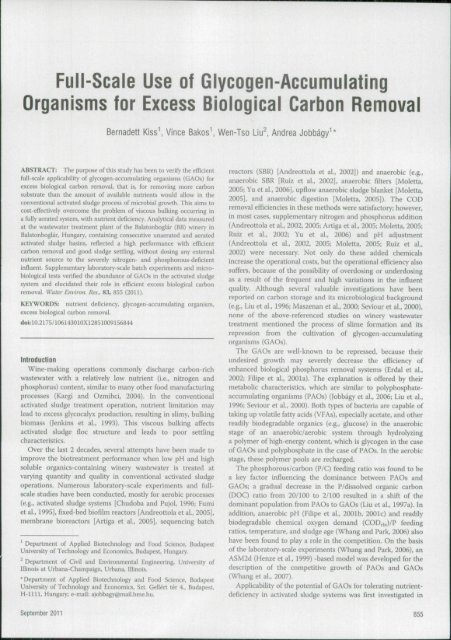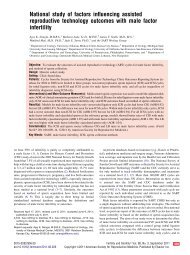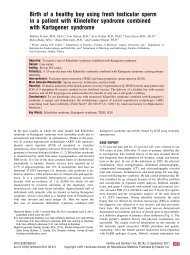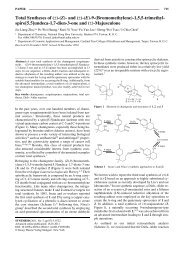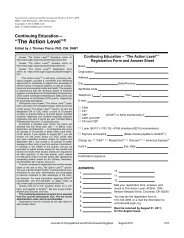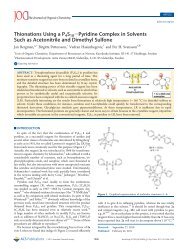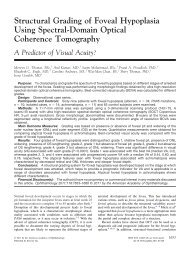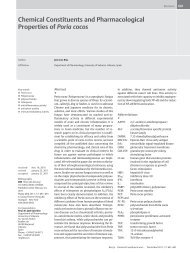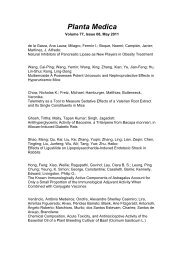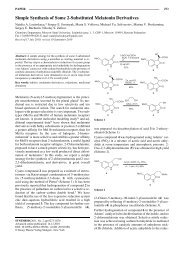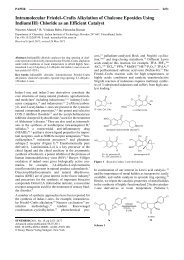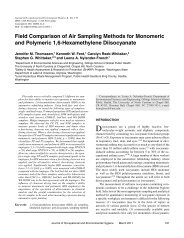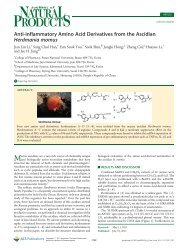Full-Scale Use of Glycogen-Accumulating Organisms for Excess ...
Full-Scale Use of Glycogen-Accumulating Organisms for Excess ...
Full-Scale Use of Glycogen-Accumulating Organisms for Excess ...
Create successful ePaper yourself
Turn your PDF publications into a flip-book with our unique Google optimized e-Paper software.
<strong>Full</strong>-<strong>Scale</strong> <strong>Use</strong> <strong>of</strong> <strong>Glycogen</strong>-<strong>Accumulating</strong><br />
<strong>Organisms</strong> <strong>for</strong> <strong>Excess</strong> Biological Carbon Removal<br />
Bernadett Kiss\ Vince Bakos\ Wen-Tso Liu^ Andrea Jobbágy^*<br />
ABSTRACT: The purpose <strong>of</strong> this study has been to verify the efficient<br />
full-scale applicability <strong>of</strong> glycogen-accumulating organisms (GAOs) <strong>for</strong><br />
excess biological carbon removal, that is, <strong>for</strong> removing more carbon<br />
substrate than the amount <strong>of</strong> available nutrients would allow in the<br />
conventional activated sludge process <strong>of</strong> microbial growth. This aims to<br />
cost-effectively overcome the problem <strong>of</strong> viscous bulking occurring in<br />
a fully aerated system, with nutrient deficiency. Analytical data measured<br />
at the wastewater treatment plant <strong>of</strong> the Balatonboglár (BB) winery in<br />
Balatonboglár, Hungary, containing consecutive unaerated and aerated<br />
activated sludge basins, reflected a high per<strong>for</strong>mance with efficient<br />
carbon removal and good sludge settling, without dosing any external<br />
nutrient source to the severely nitrogen- and phosphorous-deficient<br />
influent. Supplementary laboratory-scale batch experiments and microbiological<br />
tests verified the abundance <strong>of</strong> GAOs in the activated sludge<br />
system and elucidated their role in efficient excess biological carbon<br />
removal. Water Environ. Res., 83, 855 (2011).<br />
KEYWORDS: nutrient deficiency, glycogen-accumulating organism,<br />
excess biological carbon removal.<br />
doi:10.2175/106143010X12851009156844<br />
Introduction<br />
Wine-making operations commonly discharge carbon-rich<br />
wastewater with a relatively low nutrient (i.e., nitrogen and<br />
phosphorus) content, similar to many other food manufacturing<br />
proces.ses (Kargi and Ozmihci, 2004). In the conventional<br />
activated sludge treatment operation, nutrient limitation may<br />
lead to excess glycocalyx production, resulting in slimy, bulking<br />
biomass (Jenkins et al., 1993). This viscous bulking affects<br />
activated sludge floe structure and leads to poor settling<br />
characteristics.<br />
Over the last 2 decades, several attempts have been made to<br />
improve the biotreatment per<strong>for</strong>mance when low pH and high<br />
soluble organics-containing winery wastewater is treated at<br />
varying quantity and quality in conventional activated sludge<br />
operations. Numerous laboratory-scale experiments and fullscale<br />
studies have been conducted, mostly <strong>for</strong> aerobic processes<br />
(e.g., activated sludge systems [Chudoba and Pujol, 1996; Fumi<br />
et al., 1995], fixed-bed bi<strong>of</strong>ilm reactors [Andreottola et al., 2005],<br />
membrane bioreactors [Artiga et al, 2005], sequencing batch<br />
' Department <strong>of</strong> Applied Biotechnology and Food Science, Budapest<br />
University <strong>of</strong> Technology and Economics, Budapest, Hungary.<br />
^ Department <strong>of</strong> Civil and Environmental Engineering, University <strong>of</strong><br />
Illinois at Urbana-Champaign, Urbana, Illinois.<br />
•Department <strong>of</strong> Applied Biotechnology and Food Science, Budapest<br />
University <strong>of</strong> Technology and Economics, Szt. Geliert tér 4., Budapest,<br />
H-1111, Hungary; e-mail: ajobbagy@mail.bme.hu.<br />
reactors (SBR) [Andreottola et al., 2002]) and anaerobic (e.g.,<br />
anaerobic SBR [Ruiz et al., 2002], anaerobic filters [Moletta,<br />
2005; Yu et al., 2006], upflow anaerobic sludge blanket [Moletta,<br />
2005], and anaerobic digestion [Moletta, 2005]). The COD<br />
removal efficiencies in these methods were satisfactory; however,<br />
in most cases, supplementary nitrogen and phosphorus addition<br />
(Andreottola et al, 2002, 2005; Artiga et al., 2005; Moletta, 2005;<br />
Ruiz et al., 2002; Yu et al., 2006) and pH adjustment<br />
(Andreottola et al., 2002, 2005; Moletta, 2005; Ruiz et al.,<br />
2002) were necessary. Not only do these added chemicals<br />
increase the operational costs, but the operational efficiency also<br />
suffers, because <strong>of</strong> the possibility <strong>of</strong> overdosing or underdosing<br />
as a result <strong>of</strong> the frequent and high variations in the influent<br />
quality. Although several valuable investigations have been<br />
reported on carbon storage and its microbiological background<br />
(e.g., Liu et al., 1996; Maszenan et al., 2000; Seviour et al., 2000),<br />
none <strong>of</strong> the above-referenced studies on winery wastewater<br />
treatment mentioned the process <strong>of</strong> slime <strong>for</strong>mation and its<br />
repression from the cultivation <strong>of</strong> glycogen-accumulating<br />
organisms (GAOs).<br />
The GAOs are well-known to be repressed, because their<br />
undesired growth may severely decrease the efficiency <strong>of</strong><br />
enhanced biological phosphorus removal systems (Erdal et al.,<br />
2002; Filipe et al., 2001a). The explanation is <strong>of</strong>fered by their<br />
metabolic characteristics, which are similar to polyphosphateaccumulating<br />
organisms (PAOs) (lobbágy et al., 2006; Liu et al.,<br />
1996; Seviour et al., 2000). Both types <strong>of</strong> bacteria are capable <strong>of</strong><br />
taking up volatile fatty acids (VFAs), especially acetate, and other<br />
readily biodegradable organics (e.g., glucose) in the anaerobic<br />
stage <strong>of</strong> an anaerobic/aerobic system through hydrolyzing<br />
a polymer <strong>of</strong> high-energy content, which is glycogen in the case<br />
<strong>of</strong> GAOs and polyphosphate in the case <strong>of</strong> PAOs. In the aerobic<br />
stage, these polymer pools are recharged.<br />
The phosphorous/carbon (P/C) feeding ratio was found to be<br />
a key factor influencing the dominance between PAOs and<br />
GAOs; a gradual decrease in the P/dissolved organic carbon<br />
(DOC) ratio from 20/100 to 2/100 resulted in a shift <strong>of</strong> the<br />
dominant population from PAOs to GAOs (Liu et al., 1997a). In<br />
addition, anaerobic pH (Filipe et al., 2001b, 2001c) and readily<br />
biodegradable chemical oxygen demand (COD,.bi)/P feeding<br />
ratios, temperature, and sludge age (AXTiang and Park, 2006) also<br />
have been found to play a role in the competition. On the basis<br />
<strong>of</strong> the laboratory-scale experiments (Whang and Park, 2006), an<br />
ASM2d (Henze et al., 1999) -based model was developed <strong>for</strong> the<br />
description <strong>of</strong> the competitive growth <strong>of</strong> PAOs and GAOs<br />
(Whang et al., 2007).<br />
Applicability <strong>of</strong> the potential <strong>of</strong> GAOs <strong>for</strong> tolerating nutrientdeficiency<br />
in activated sludge systems was first investigated in<br />
September 2011 855
Kiss et al.<br />
Preclarified<br />
—; i^i T- »•<br />
influent ANA<br />
1.<br />
Figure 1—Schematic <strong>of</strong> tbe fuii-scale piant.<br />
ANA<br />
2.<br />
AE<br />
I./l<br />
AE<br />
II./I<br />
Recycled sludge<br />
laboratory- and pilot-scale systems (Harper and Jenkins, 2001;<br />
Jobbágy et al., 2002) using simulated wastewater. Harper and<br />
Jenkins (2001) applied a laboratory-scale anaerobic-aerobic<br />
activated sludge system with a variable organic load at constant<br />
phosphorus, in controlling phosphorous deficiency successfully.<br />
Jobbágy et al. (2002) used highly nitrogen- and phosphorusdeficient<br />
simulated winery wastewater <strong>for</strong> promoting the growth<br />
<strong>of</strong> GAOs in a pilot-seale sequential anaerobic-aerobic activated<br />
sludge system, thereby avoiding slime-<strong>for</strong>mation without dosing<br />
an external nutrient source.<br />
The current study focuses on the evaluation <strong>of</strong> this novel,<br />
anaerobic-aerobic activated sludge excess biological earbon<br />
removal (EBCR) teehnology <strong>for</strong> winery wastewater treatment at<br />
full-seale. The main objeetive has been to investigate the<br />
effieieney and prove that it is a eonsequenee <strong>of</strong> the growth <strong>of</strong><br />
GAOs.<br />
Methodology<br />
<strong>Full</strong>-<strong>Scale</strong> Studies. At the Balatonboglár (BB) winery<br />
wastewater treatment plant (WWTP) with the first full-seale<br />
implementation <strong>of</strong> the EBCR teehnology, the pre-elarified<br />
influent is fed into two non-aerated basins (Figure 1). The<br />
anaerobie effluent is divided into two parallel streams and<br />
treated aerobically in two consecutive aerated basins. The<br />
secondary effluent is discharged to the domestic sewer system.<br />
During the investigation, only one <strong>of</strong> the treatment trains was in<br />
operation, as a result <strong>of</strong> the relatively low influent flowrate. At<br />
the plant, primary and seeondary sludges are treated in<br />
a thickener and in a gravitational dewatering unit. The sludge<br />
processing waste is recirculated into a wet well preceding the<br />
preclarification stage.<br />
Because the influent flowrates and pollution loads <strong>of</strong> a winery<br />
WWTP may vary greatly with the different wine-processing<br />
periods (i.e., vintage, racking, and bottling) and with the wineproducing<br />
technology used (e.g., production <strong>of</strong> red, white, or<br />
special wines) (Kargi and Ozmihei, 2004), the per<strong>for</strong>manee was<br />
investigated throughout a whole year. Samples were taken<br />
between September 2005 and August 2006 at 2-week intervals<br />
from 12 sampling points—preclarifier, six reactors, two secondary<br />
clarifiers, plant effluent, thickener, and dewatering unit.<br />
The operational parameters monitored during the experiment<br />
ineluded temperature, pH, and dissolved oxygen eoneentration,<br />
while the system per<strong>for</strong>manee was evaluated by measuring the<br />
eoneentrations <strong>of</strong> ehemieal oxygen demand (COD), filtered<br />
AE<br />
I./2<br />
AE<br />
II./2<br />
wmmmm<br />
^..^^^..^<br />
, clarif.^<br />
V _^<br />
L•— ....1<br />
Secondary<br />
effluent<br />
COD, 5-day bioehemieal oxygen demand (BOD5), total organic<br />
carbon (TOC), total nitrogen (TN), ammonia, nitrate, nitrite,<br />
phosphate, total phosphorus, total suspended solids (TSS), and<br />
sludge volume index (SVI). In addition to these commonly<br />
investigated parameters, the aeetate concentration <strong>of</strong> the<br />
wastewater samples was measured by gas chromatography<br />
(using an ATI Unicam 610 series gas Chromatograph, ATI,<br />
Cambridge, United Kingdom). Total carbohydrate concentration<br />
and intra- and extracellular carbohydrate concentrations <strong>of</strong> the<br />
activated sludge biomass also were determined according to the<br />
procedure developed earlier by Jobbágy et al. (2002).<br />
Batch Experiment. To obtain further verification on the<br />
presence and treatment activity <strong>of</strong> GAOs, three supplementary<br />
batch tests were carried out, in which the anaerobie and eventual<br />
anoxic carbon consumptions <strong>of</strong> the biomass <strong>of</strong> the winery<br />
WWTP were followed in comparison with those <strong>of</strong> a biomass<br />
originating from a domestic WWTP. To investigate whether the<br />
anaerobic organic uptake was the result <strong>of</strong> the presence <strong>of</strong> GAOs<br />
and/or PAOs, both <strong>of</strong> the sludges were put into alternating<br />
anaerobic-aerobic conditions.<br />
The activated sludges taken either from the anaerobic reactor<br />
<strong>of</strong> the winery treatment plant or from a domestic WWTP's anoxic<br />
tank were aerated <strong>for</strong> a 10-hour period. Having the original<br />
Tabie 1—Initiai nutrient compositions used in the batch tests.<br />
Experiment 1<br />
Experiment 2<br />
Experiment 3<br />
Substance<br />
Activated sludge<br />
Peptone<br />
Sodium-acetate<br />
KH2PO4<br />
K2HPO4<br />
MgS04<br />
CaCl2<br />
KNOa*<br />
Effluent <strong>of</strong> a domestic WWTP<br />
Sodium-acetate<br />
KNOa*<br />
1:1 mixture <strong>of</strong> a domestic<br />
WWTP effluent and <strong>of</strong> the<br />
Winery WWTP effluenf<br />
Sodium-acetate<br />
KNOa*<br />
* Added only in the second unaerated phase<br />
Concentration (mg/L)<br />
1500<br />
160<br />
200 (acetate)<br />
18<br />
22<br />
40<br />
16<br />
300<br />
200 (acetate)<br />
300<br />
200 (acetate)<br />
300<br />
856 Water Environment Research, Volume 83, Number 9
O)<br />
O<br />
O<br />
O<br />
Figure 2—Influent and effluent COD concentrations in the treatment plant.<br />
carbon source and dissolved orthophosphate <strong>of</strong> the samples<br />
consumed, both sludges were transferred into stirred "no-head<br />
space" reactors, closed hermetically with a piston (Jobbágy et al.,<br />
2000). Because the sampling tap was on the bottom <strong>of</strong> the reactor,<br />
the penetration <strong>of</strong> oxygen through the surface was avoided during<br />
the operation.<br />
In the anaerobic experimental phase, according to Table 1,<br />
external carbon sources (sodium-acetate and peptone), nutrients,<br />
and micro-elements were added to the experimental<br />
systems. In the first experiment, the external substrates served<br />
as sole carbon sources. However, in the second experiment, the<br />
supplements (sodium-acetate, and potassium nitrate [KNO3]).<br />
were dissolved primarily in the clarified effluent <strong>of</strong> a municipal<br />
WWTP, whereas, in the third experiment, the supplements were<br />
dissolved in a 1:1 mixture <strong>of</strong> the clarified effluents <strong>of</strong> a municipal<br />
plant and <strong>of</strong> the winery WWTP (see Table 1) to provide a wide<br />
spectrum <strong>of</strong> micro-elements eventually necessary <strong>for</strong> the<br />
Figure 3—Ratio <strong>of</strong> nutrients in the filtered samples <strong>of</strong> the influent wastewater.<br />
• Influent<br />
M Effluent<br />
- ^ - Filtered influent<br />
- B - Filtered effluent<br />
Kiss et al.<br />
microorganisms. The DOC, acetic acid, dissolved nitrogen, and<br />
orthophosphate concentrations were measured every 15 minutes<br />
in the first hour and every 30 minutes <strong>for</strong> an additional 8 hours.<br />
Then, the sludges were placed into the aerated reactors again<br />
and left there overnight. On the following day, the sludges were<br />
transferred back into the no-head space reactors, where carbon<br />
source was repeatedly added to the systems, but the conditions<br />
were set to be anoxic with nitrate addition (as indicated in<br />
Table 1), to investigate the denitrification capacity <strong>of</strong> the<br />
different sludges.<br />
The intra- and extracellular carbohydrate concentrations <strong>of</strong><br />
the investigated sludges also were measured. Continuous<br />
monitoring <strong>of</strong> pH throughout the experiments indicated that<br />
the variation was insignificant, in the range 6.3 to 6.7.<br />
Microbiological Studies. Microscopic investigation <strong>of</strong> the<br />
biomass, focused on the detection <strong>of</strong> GAOs in the full-scale<br />
winery WWTP, was carried out using a direct light microscope<br />
• Influent P/COD<br />
Influent N/COD<br />
September 2011 857
Kiss et al.<br />
ANA ANA AE1/1<br />
Figure 4—Filtered COD pr<strong>of</strong>iies measured during tiie expérimentai period.<br />
(Olympus CX41, Olympus, Tokyo, Japan), The sludge samples,<br />
collected over the 12-month experimental period, were analyzed<br />
under direct light and phase contrast at 200X, 400X, and lOOOX<br />
magnifications. To verify the absence <strong>of</strong> extracellular polysaccharide<br />
overproduction, India ink reverse staining technique<br />
was applied, according to Jenkins et al, (1993), in addition to the<br />
native observations on the samples,<br />
Eluorescence In Situ Hybridization. The presence <strong>of</strong> GAOs<br />
in the full-scale winery WWTP was visualized using FISH<br />
analysis per<strong>for</strong>med on the biomass samples collected over a 12month<br />
experimental period.<br />
The FISH was applied on para<strong>for</strong>maldehyde (PFA) and<br />
ethanol-fixed activated sludge samples <strong>for</strong> gram-negative<br />
bacteria and gram-positive bacteria, according to the protocol<br />
described by Amman et al, (1995), The PFA-fixed samples were<br />
Figure 5—infiuent and effiuent ortiiopiiospiiate concentrations.<br />
03-Oct-05<br />
19-Oct-05<br />
—*~-03-Nov-05<br />
- >* 16-NOV-05<br />
—•—30-NOV-05<br />
11-Jan-06<br />
01-Feb-06<br />
01-Mar-06<br />
22-Mar-06<br />
05-Apr-06<br />
26-Apr-06<br />
09-May-06<br />
30-May-06<br />
20-Jun-06<br />
04-JUI-06<br />
19-Jul-06<br />
AE1/2 Secondary Effluent<br />
clarifier<br />
investigated <strong>for</strong> Alpha-, Beta-, and Gammaproteobacteria, <strong>for</strong><br />
the Cytophaga-Flexibacter group <strong>of</strong> the Bacteroides, Actinobacteria,<br />
and Defluvicoccus-related tetrad-<strong>for</strong>ming organisms<br />
(TFOs), D. vanus and 1 and 2 subgroups in G-bacteria, as<br />
described by Wong et al, (2004),<br />
Microscopic images were acquired using an epifluorescence<br />
microscope (model BX51, Olympus) and a confocal laser<br />
scanning microscope (CLSM, model LSM 5 Pascal, Carl Zeiss,<br />
Hamburg, Germany), Image processing and analysis were<br />
per<strong>for</strong>med with the s<strong>of</strong>tware package provided by Zeiss,<br />
Metamorph (Universal Imagine) (Molecular Devices Inc,<br />
Sunnyvale, Cali<strong>for</strong>nia), and Adobe Photoshop (Adobe Systems,<br />
San José, Cali<strong>for</strong>nia) s<strong>of</strong>tware. An abundance <strong>of</strong> different<br />
bacterial groups was derived from the semi-quantitative<br />
measurements described by Wong et al, (2004), The values <strong>of</strong><br />
' influent<br />
-Effluent<br />
858 Water Environment Researcti, Volume 83, Number 9
Figure 6—infiuent and effiuent totai nitrogen concentrations.<br />
percentage abundance obtained <strong>for</strong> each probe were averaged,<br />
and the standard deviations <strong>of</strong> the mean were calculated.<br />
Terminal Restriction Fragment Length Polymorphism. The<br />
temporal changes <strong>of</strong> the microbial communities were analyzed<br />
using the terminal restriction fragment length polymorphism (T-<br />
RFLP) technique. Total community DNA was extracted (Liu et al.,<br />
1997b), and 16s rRNA genes were amplified using the Bacteriaspecific<br />
<strong>for</strong>ward primer 47F (5' Cy5-CYT AAC AC A TGC AAG<br />
TCG-3') and the reverse primer 927R (5'-ACC GCT TGT GCG<br />
GGC CC-3') (Legendre and Gallagher, 2001). The polymerase<br />
chain reaction (PCR) products were purified and digested<br />
separately using two different tetrameric restriction enzymes—<br />
Mspl and Hhal, respectively. Capillary electrophoresis separation<br />
<strong>of</strong> terminal restriction fragments (T-RFs) was per<strong>for</strong>med according<br />
to a previously described protocol (Liu et al., 1997b) in a CEQ<br />
8000 automated sequencer (Beckman Coulter, Brea, Cali<strong>for</strong>nia).<br />
Statistical analyses <strong>of</strong> T-RFLP fingerprints were per<strong>for</strong>med using<br />
MINITAB Statistical S<strong>of</strong>tware (Minitab Inc., State College,<br />
Pennsylvania). The Hellinger distance was calculated from the<br />
Euclidean distance after square root trans<strong>for</strong>mation <strong>of</strong> relative<br />
peak areas (Legendre and Gallagher, 2001). A distance matrix<br />
based on the Hellinger distance was computed, and the dendrogram<br />
and multidimensional scaling analysis <strong>of</strong> clusters was<br />
generated using Ward's hierarchical-clustering method.<br />
Phylogenetic assignments were generated in silico from the<br />
community T-RFLP pr<strong>of</strong>iles based on a database <strong>of</strong> fragments<br />
produced by known 16S rRNA gene sequences. The Microbial<br />
Community Analysis III website at the University <strong>of</strong> Idaho<br />
(Boise, Idaho) (http://mica.ibest.uidaho.edu) produces a database<br />
<strong>of</strong> phylogenetically known T-RF lengths based on 16S rRNA<br />
gene sequences presently available and on user input <strong>of</strong> PCR<br />
primers and restriction enzymes. This database served as input<br />
to the Phylogenetic Assignment Tool (PAT) s<strong>of</strong>tware (North<br />
Temperate Lakes Microbial Observatory, University <strong>of</strong> Wisconsin,<br />
Madison, Wisconsin), which automates the task <strong>of</strong><br />
phylogenetic assignment from T-RF pr<strong>of</strong>iles produced by<br />
multiple enzyme digestions.<br />
Influent<br />
Effluent<br />
• Filtered influent<br />
- Filtered effluent<br />
Kiss et ai.<br />
Resuits and Discussion<br />
<strong>Full</strong>-<strong>Scale</strong> Studies. The flowrate <strong>of</strong> the influent wastewater<br />
fluctuated highly, resulting in a hydraulic retention time <strong>of</strong> 1 to<br />
1.5 days. The mixed-liquor suspended solids (MLSS) concentration<br />
in the basins was 6.5 g/L as a yearly average (with<br />
a minimum <strong>of</strong> 4.4 g/L and a maximum <strong>of</strong> 7.7 g/L), and the solids<br />
residence time (SRT) characteristically exceeded 10 days. The<br />
average influent pH was as low as 5.4 and fluctuated within the<br />
range <strong>of</strong> 4.2 to 6.3. However, pH values measured in the<br />
bioreactors never remained below 6.4 and fell characteristically<br />
between 6.7 and 8.2. This change can be attributed to the rapid<br />
consumption <strong>of</strong> VFAs, especially acetic acid detected in the<br />
system. The temperature in the bioreactors increased up to 35 to<br />
38°C in summer and did not drop below 15°C, even in winter.<br />
50<br />
45<br />
g 40<br />
(O 35<br />
-i 30<br />
• Bctracellular<br />
• Intracellular<br />
DOM WIN<br />
Figure 7—Intra- and extracellular carbohydrate content <strong>of</strong> the<br />
domestic (controi system) and winery activated siudge treatment<br />
biomass on iVIay 11, 2006.<br />
September 2011 859
Kiss et al.<br />
23 March 24 March<br />
WIN I DOM<br />
06 April<br />
• c consumption relatable to GAOs<br />
• C consumption relatable to PAOs+denitrification<br />
WIN : DOM<br />
07 April<br />
WIN DOM<br />
10 May<br />
WIN DOM<br />
Figure 8—Dissolved organic carbon consumption ot the winery (WIN) and domestic (DOM) activated sludges in the unaerated stages ot<br />
the batch experiments.<br />
The influent and effluent COD values are depicted in Figure 2.<br />
The influent COD fluctuated highly, within the range 620 to 10<br />
870 mg/L. Despite this fact and the severe nutrient deficiency (see<br />
Figure 3), very good COD removal efficiency and a low and<br />
relatively stable effluent COD level could be achieved. The<br />
effluent COD concentration dropped far below the prescribed<br />
1000-mg/L limit and generally did not exceed 320 mg/L. The only<br />
exception was the 1711-mg/L effluent COD value detected on<br />
October 3, when the aeration had not been sufficient over the<br />
weekend be<strong>for</strong>e the sample collection. Filtered COD data (see<br />
Figure 4) acquired from samples collected at different points <strong>of</strong><br />
the winery WWTP showed that most <strong>of</strong> the carbon source already<br />
was eliminated in the anaerobic stage.<br />
The infiuent total dissolved nitrogen-to-COD ratio was always<br />
far below 2% (typical value
Kiss et al.<br />
Figure 10—TFOs in the winery wastewater: (a) Neisser-positíve GAOs, see dots in dark gray, 1000x; (b) gram-negative GAOs in iight<br />
gray on the right side, 1000X; (c) GAOs with biack PHB granuies, 1000x; (d) gray tetrads in phase contrast 400x; (e) white spots by<br />
ink reverse staining, 200x; and (f) dark gray tetrads in phase contrast, 1000x.<br />
total nitrogen could be attributed to suspended materials,<br />
because the filtered influent was found to contain low<br />
concentrations <strong>of</strong> total nitrogen (see Figure 6). The effluent<br />
nitrate concentration <strong>of</strong> the aerobic reactor was found to be<br />
practically zero at a very low dissolved total nitrogen level. This<br />
can be explained by the severe nutrient deficiency that prevented<br />
nitrification. Because <strong>of</strong> this fact and the lack <strong>of</strong> influent nitrate,<br />
no denitrification occurred either. All <strong>of</strong> these experimental<br />
results support the assumption that GAOs are present in the<br />
plant and the nutrient defieieney is balaneed through their<br />
metabolism.<br />
The total earbohydrate eontent and the ratio <strong>of</strong> the intra- and<br />
extraeellular carbohydrate concentrations <strong>of</strong> the winery biomass<br />
compared with a domestic biomass are illustrated in Figure 7. In<br />
the biomass <strong>of</strong> the winery WWTP, both the total carbohydrate<br />
concentration (approximately 47%) and the intracellular carbo-<br />
Wards method<br />
Euclkiean distances 1,0 »6.02.01 AE<br />
hydrate ratio (>72%) were much higher than in the biomass <strong>of</strong><br />
the munieipal plant (approximately 15 and 50%), whieh is<br />
adequate <strong>for</strong> the enhancement <strong>of</strong> GAOs (Jobbágy et al., 2002).<br />
Bateh Experiment. Aeeording to the protoeol deseribed<br />
above, the first unaerated experimental phases represent the<br />
anaerobie conditions, whereas, in the second experimental<br />
phases, the systems were operated anoxically. The carbon<br />
consumption was followed through the measurement <strong>of</strong> DOC.<br />
From the measured orthophosphate release, the PAO-assoeiated<br />
earbon eonsumption was ealeulated aeeording to the anaerobie<br />
phosphorus-release/aeetate uptake ratio given by Sehuler and<br />
Jenkins (2003) (<strong>for</strong> the winery sludge, the eoeffieient <strong>of</strong><br />
0.015 mol P/C-mol was used, suggesting that it was GAOdominated,<br />
whereas, <strong>for</strong> the domestie sludge, the intermediate<br />
value <strong>of</strong> 0.25 mol P/C-mol was ehosen, as no data were available<br />
regarding its GAO and PAO content). Under anoxie conditions.<br />
0,5<br />
i 0.0<br />
Q<br />
-0.5<br />
-1,0<br />
-1,5<br />
2006,02.01 AN<br />
2006.07.19 AE<br />
2006,07.19 AN<br />
rtjJCMÄE<br />
3t7mi«E<br />
2006.04.06 AN<br />
2006.04 05 AE<br />
-1,2 -1,0 -0.8 -0,6 -0,4 -0,2 0.0 0.2 0,4 0.6 0.8 1.0 1,2 1.4 1,6 1.8<br />
Figure 11—Oendogram and muitidimension piotting <strong>of</strong> the ciuster anaiysis on the T-RFLP pr<strong>of</strong>iie obtained after digestion by Hhai.<br />
enzyme <strong>of</strong> PCR amplifying ot the 16S rRNA gene <strong>for</strong> the domain Bacteria <strong>for</strong> the seiected samples.<br />
September 2011 861<br />
Dmension 1
Kiss et al.<br />
Table 2—TFO groups found in the database <strong>of</strong> University <strong>of</strong> Idaho by in silico analysis <strong>of</strong> the T-RFLP results.<br />
Bacteria<br />
Uncultured bacterium TF0a42.<br />
Uncultured bacterium TF0a21.<br />
Uncultured bacterium TF0a26.<br />
Uncultured bacterium TF0c39.<br />
Uncultured bacterium TF0c18.<br />
Uncultured bacterium TFOa28.<br />
Uncultured bacterium TFOa43.<br />
Uncultured bacterium TF0a44.<br />
Uncultured bacterium TFGa5.<br />
Uncultured bacterium TFOb30.<br />
Uncultured bacterium TF0b5.<br />
Uncultured bacterium TF0b29.<br />
Hhal. (%)<br />
-<br />
1.54 to 10.77<br />
2.43 to 10.77<br />
the organic consumption relatable to denitrifiers eventually<br />
present in the system was tracked by measuring the nitrate<br />
concentration. As the heterotrophic yield factor {YH) proved to<br />
be 0.43 mg COD biomass/mg COD substrate, it was assumed<br />
that 5.02 mg COD was consumed to reduce 1 mg NO3-N by<br />
denitrifiers (Ekama et al., 1986).<br />
Results <strong>of</strong> the batch tests indicated that the biomass <strong>of</strong> the<br />
winery WWTP consumed the carbon source overwhelmingly<br />
under anaerobic conditions. This microbial activity could be<br />
attributed mainly to the metabolism <strong>of</strong> GAOs (see Figure 8).<br />
The denitriñcation capacity <strong>of</strong> the biomass <strong>of</strong> the winery<br />
treatment plant was low, as the carbon consumption under<br />
anoxic conditions was accompanied by just a minor decrease in<br />
nitrate concentration (specific denitrification rate, ko = 0 to<br />
0.4 mg TN/g MLSS h~ '). On the contrary, organic consumption<br />
<strong>of</strong> the biomass <strong>of</strong> the domestic WWTP derived mainly from<br />
denitrification under unaerated conditions. The highest measured<br />
specific denitrification rate was ArD=18.5 mg TN/g MLSS<br />
h^'. The observed minor carbon consumption in the anaerobic<br />
experimental phases did not refer to the presence <strong>of</strong> PAOs,<br />
rather to the denitrification <strong>of</strong> the nitrate generated during the<br />
preceding overnight aeration phases, as carbon consumption<br />
generally stopped when nitrate had been used up in the system.<br />
Considerable orthophosphate release was not detected either in<br />
the municipal or in the winery sludge-containing systems.<br />
Characterization <strong>of</strong> the Biomass. The SVI values obtained<br />
from settling sludges deriving from the last aerobic reactor <strong>of</strong> the<br />
full-scale plant are depicted in Figure 9. During the vintage and<br />
bottling seasons, the SVI values ranged from 150 to 200 cm^/g,<br />
whereas, in the filtering season, the values proved to be<br />
remarkably lower—generally between 100 and 140 cm'^/g.<br />
Although the wastewater was severely nutrient-deficient, these<br />
SVI values, obtained without the addition <strong>of</strong> external nitrogen<br />
and phosphorus sources to the infiuent, referred to good sludge<br />
settling properties and suggested the presence <strong>of</strong> GAOs, in<br />
accordance with earlier pilot-scale findings (Jobbágy et al., 2002).<br />
To determine whether GAOs were present in the sludge<br />
samples, various staining methods were used <strong>for</strong> microscopic<br />
examination (see Figure 10). Morphologically distinct TFOs<br />
were observed in all <strong>of</strong> the samples taken from the winery<br />
WWTP (Figures lOd and lOf). In addition, the TFOs were<br />
stained Neisser-positive and Gram-negative (Figures 10a and<br />
2006.02.01 2006.07.19<br />
Mspl. (%)<br />
-<br />
1.68<br />
18.93<br />
Hhai. (%)<br />
1.1 to 3.7<br />
2.4<br />
1.0 to 2.4<br />
4<br />
Mspl. (%)<br />
5.3<br />
5.1<br />
1.6 to 2.6<br />
2.0 to 5.5<br />
10b, respectively), in accordance with the findings <strong>of</strong> Jenkins et<br />
al. (1993). The presence <strong>of</strong> stored polyhydroxy-butyrate also<br />
could be confirmed by PHB staining (Figure 10c), and no severe<br />
overproduction <strong>of</strong> extracellular polymeric material was detected<br />
in the samples, as shown by ink reverse staining (Figure lOe).<br />
The SVI was relatively stable in the vintage and bottling<br />
seasons and decreased during the filtering season. To determine<br />
the cause <strong>of</strong> this fluctuation, six sludge samples from different<br />
seasons were chosen <strong>for</strong> further analysis using T-RFLP.<br />
Clustering based on dendrogram and multi-dimensional scaling<br />
analysis showed that microbial compositions found during the<br />
vintage and bottling seasons were largely similar (Figure 11) and<br />
corresponded to SVI values that were relatively constant<br />
(between 150 to 200 cmVg). However, microbial communities<br />
associated with the filtering season were distinctly different<br />
(Figure 11) and coincided with the period <strong>of</strong> lower SVI readings<br />
(100 to 140 cm^/g). Taken together, the results here suggested<br />
that changes in the influent wastevrater could affect the SVI (and<br />
there<strong>for</strong>e the sedimentation characteristics) <strong>of</strong> the biomass.<br />
Figure 12—CLSM micrographs <strong>of</strong> FISH showing gross fluorescently<br />
labeled bacteria (gray) and the tetrad-<strong>for</strong>ming GAOs<br />
typical in the BB winery's activated sludge (white spots).<br />
862 Water Environment Research, Volume 83, Number 9
Tabie 3—Abundance (%) 1 <strong>of</strong> major phyiogenetic groupsand<br />
GAOs in tbe biomass determined by FiSH.<br />
Ptiylogenetic gorup<br />
Alptiaproteobacteria<br />
'Defíuwcoccus-related TFO<br />
Betaproteobacteria<br />
Gammaproteobacteria<br />
Cytophaga-Flexibacter<br />
group ot Bacteroides<br />
Actinobacteria<br />
rRNA oligonucleotide 13<br />
probe<br />
ALF968<br />
TFO DF218<br />
BET42a<br />
GAM42a<br />
CF319a<br />
HGC69a<br />
September<br />
2005<br />
43 ± 6<br />
16 ± 6<br />
14 ± 9<br />
11 ±4<br />
Kiss et al.<br />
Submitted <strong>for</strong> publication August S, 2010; revised manuscript<br />
submitted December 8, 2010; accepted <strong>for</strong> publication December<br />
16, 2010.<br />
References<br />
Amman, R.; Ludwig, W.; Schleifer, K.-H. (1995) Phylogenetic Identification<br />
and In Situ Detection <strong>of</strong> Individual Microbial Cells without<br />
Cultivation. Mierobiol Rev., 59,143-169.<br />
Andreottola, G.; Foladori, P.-, Nardelli, P.; Denicolo, A. (2005) Treatment<br />
<strong>of</strong> Winery Wastewater in a <strong>Full</strong>-<strong>Scale</strong> Fixed Bed Bi<strong>of</strong>ilm Reactor.<br />
Water Sel Teehnol, 51, 71-79.<br />
Andreottola, G.; Foladori, P.; Ragazzi, M.; Villa, R. (2002) Treatment <strong>of</strong><br />
Winery Wastewater in a Sequencing Batch Bi<strong>of</strong>ilm Reactor. Water<br />
Sel Teehnol, 45, 347-354.<br />
Artiga, P.; Ficara, E.; Malpei, F.; Garrido, J. M.; Méndez, R. (2005)<br />
Treatment <strong>of</strong> Two Industrial Wastewaters in a Submerged Membrane<br />
Bioreactor. Desalination, 179, 161-169.<br />
Chen, C. L.; Macarie, H.; Ramirez, I.; Olmos, A.; Ong, S. L.; Monroy, O.;<br />
Liu, W. T. (2004) Microbial Community Structure in a Thermophilic<br />
Anaerobic Hybrid Reactor Degrading Terephthalate. Microbiology,<br />
150, 3429-3440.<br />
Chudoba, P.; Pujol, R. (1996) Activated Sludge Plant Facing Grape<br />
Harvest Period—A Case Study. Water Scl Technol, 34, 25-32.<br />
Ekama, G. A.; Dold, P. L.; Marais, G. v. R. (1986) Procedures <strong>for</strong><br />
Determining Influent COD Fractions and the Maximum Specific<br />
Growth Rate <strong>of</strong> Heterotropbs in Activated Sludge System. Water<br />
Sel Teehnol, 18, 91-114.<br />
Erdal, U. G.; Erdal, Z. K.; Randall, C. W. (2002) The Competition<br />
Between PAOS's and GAOS's in EPBR Systems at Different<br />
Temperatures and the Effects on System Per<strong>for</strong>mance. Paper<br />
e20420, Enviro 2002 & ¡WA World Water Congress, Melbourne,<br />
Australia, 7-12 April; International Water Association; London,<br />
United Kingdom.<br />
Filipe, C. D. M.; Daigger, G. T.; Grady, C. P. L. (2001a) A Metabolic<br />
Model <strong>for</strong> Acetate Uptake Under Anaerobic Conditions by<br />
<strong>Glycogen</strong> <strong>Accumulating</strong> <strong>Organisms</strong>; Stoichiometry, Kinetics, and<br />
the Effect <strong>of</strong> pH. Bioteehnol Bioeng, 76, 17-31.<br />
Filipe, C. D. M.; Daigger, G. T.; Grady )r, L. (2001b) Effects <strong>of</strong> pH on the<br />
Rates Plug-Flow Aerobic Metabolism <strong>of</strong> Phosphate-<strong>Accumulating</strong><br />
and <strong>Glycogen</strong>-<strong>Accumulating</strong> <strong>Organisms</strong>. Water Environ. Res., 73,<br />
213-222.<br />
Filipe, C. D. M.; Daigger, G. T.; Grady Jr., L. (2001c) pH as a Key Factor in the<br />
Competition Between <strong>Glycogen</strong>-<strong>Accumulating</strong> <strong>Organisms</strong> and Phosphate-<strong>Accumulating</strong><br />
<strong>Organisms</strong>. Water Environ. Res., 73, 223-232.<br />
Fumi, M. D.; Parodi, G.; Parodi, E.; Silva, A.; Marchetti, R. (1995)<br />
Optimization <strong>of</strong> Long-Term Activated-Sludge Treatment <strong>of</strong> Winery<br />
Wastewater. Bioresour. Teehnol, 52, 45-51.<br />
Harper, W. F.; Jenkins, D. (2001) The Effect <strong>of</strong> an Initial Anaerobic Zone<br />
on the Nutrient Requirements <strong>of</strong> Activated Sludge. Proeeedings <strong>of</strong><br />
the 74th Annual Water Environment Federation Teehnieal Exposition<br />
and Conferenee, Atlanta, Georgia, Oct. 13-17; Water<br />
Environment Federation; Alexandria, Virginia.<br />
Henze, M.; Gujer, W.; Mino, T.; Matsuo, T.; Wentzel, M. C; Marais, G. v.<br />
R.; Van Loosdrecht, M. C. M. (1999) Activated Sludge Model<br />
No. ASM2d. Water Sel Teehnol, 39, 165-183.<br />
Jenkins, D.; Richard, M. G.; Daigger, G. T. (1993) Manual on the Causes<br />
and Control <strong>of</strong> Aetivated Sludge Bulking and Foaming, 2nd ed.;<br />
Lewis Publishers; Ann Arbor, Michigan.<br />
Jobbágy, A.; Literáthy, B.; Tardy, G. (2002) Implementation <strong>of</strong> <strong>Glycogen</strong><br />
<strong>Accumulating</strong> Bacteria in Treating Nutrient-Deficient Wastewater.<br />
WaUr Sel Teehnol, 46, 185-190.<br />
Jobbágy, A.; Literáthy, B.; Wong, M.-T.; Tardy, G.; Liu, W.-T. (2006)<br />
Proliferation <strong>of</strong> <strong>Glycogen</strong> <strong>Accumulating</strong> <strong>Organisms</strong> Induced by<br />
Fe(III) Dosing in a Domestic Wastewater Treatment Plant. Water<br />
Sel Teehnol, 54, 101-109.<br />
Jobbágy, A.; Simon, J.; Plósz, B. (2000) The Impact <strong>of</strong> Oxygen Penetration<br />
on the Estimation <strong>of</strong> Denitrification Rates in Anoxic Processes.<br />
Water Res., 34, 2606-2609<br />
Kargi, F.; Ozmihci, S. (2004) Batch Biological Treatment <strong>of</strong> Nitrogen<br />
Deficient Synthetic Wastewater Using Azotobaeter Supplemented<br />
Activated Sludge. Bioresour Teehnol, 94, 113-117.<br />
Kent, A. D.; Smith, D. J.; Benson, B. J.; Triplett, E. W. (2003) Web-Based<br />
Pbylogenetic Assignment Tool <strong>for</strong> Analysis <strong>of</strong> Terminal Restriction<br />
Fragment Length Polymorphism Pr<strong>of</strong>iles <strong>of</strong> Microbial Communities.<br />
Appl Environ. Mierobiol, 69, 6768-6776.<br />
Legendre, P.; Gallagher, E. D. (2001) Ecologically Meaningful Trans<strong>for</strong>mations<br />
<strong>for</strong> Ordination <strong>of</strong> Species Data. Oeeologia, 129, 271-280.<br />
Liu, W.-T.; Marsh, L. T.; Cheng, H.; Forney, J. L. (1997b) Characterization<br />
<strong>of</strong> Microbial Diversity by Determining Terminal Restriction<br />
Fragment Length Polymorphisms <strong>of</strong> Genes Encoding 16S rRNA.<br />
Appl Environ. Mierobiol, 63, 4516-4522.<br />
Liu, W.-T.; Mino, T.; Nakamura, K.; Matsuo, T. (1996) <strong>Glycogen</strong><br />
<strong>Accumulating</strong> Population and Its Anaerobic Substrate Uptake in<br />
Anaerobic-Aerobic Activated Sludge without Biological Phosphorous<br />
Removal. Water Res., 30, 75-82.<br />
Liu, W.-T.; Nakamura, K.; Matsuo, T.; Mino, T. (1997a) Internal Energy-<br />
Based Competition Between Polyphosphate- and <strong>Glycogen</strong>-<strong>Accumulating</strong><br />
Bacteria in Biological Phosphorous Removal Reactors—<br />
Efi'ect <strong>of</strong> P/C Feeding Ratio. Water Res., 31, 1430-1438.<br />
Maszenan, A. M.; Seviour, R. J.; Patel, B. K. C; Wanner, J. (2000) A<br />
Fluorescently-Labelled R-RNA Targeted Oligonucleotide Probe <strong>for</strong><br />
the In Situ Detection <strong>of</strong> G-Bacteria <strong>of</strong> the Genus Amarieoeeus in<br />
Activated Sludge. /. Appl Mierobiol, 88, 826-835.<br />
Moletta, R. (2005) Winery and Distillery Wastewater Treatment by<br />
Anaerobic Digestion. Water Sel Technol, 51, 137-144.<br />
Ruiz, C; Torrijos, M.; Sousbie, P.; Martinez, J. L.; Moletta, R.; Delgenes, J.<br />
P. (2002) Treatment <strong>of</strong> Winery Wastewater by an Anaerobic<br />
Sequencing Batch Reactor. Water Sel Teehnol, 45, 219-224.<br />
Schüler, A. J.; Jenkins, D. (2003) Enhanced Biological Phosphorous<br />
Removal from Wastewater by Biomass with Different Phosphorous<br />
Contents. Water Environ. Res., 75, 485-498.<br />
Seviour, R. J.; Maszenan, A. M.; Soddell, J. A.; Tandoi, V.; Patel, B. K. C;<br />
Kong, Y.; Schumann, P. (2000) Microbiology <strong>of</strong> the 'G-Bacteria' in<br />
Activated Sludge. Minireview. Environ. Mierobiol, 2, 581-593.<br />
Whang, L. M.; Filipe, C. D. M.; Park, J. K. (2007) Model-Based Evaluation<br />
<strong>of</strong> Competition Between Polyphosphate- and <strong>Glycogen</strong>-<strong>Accumulating</strong><br />
<strong>Organisms</strong>. Water Res., 41, 1312-1324.<br />
Whang, L. M.; Park, J. K. (2001) Competition Between Poly-Phosphateand<br />
<strong>Glycogen</strong> <strong>Accumulating</strong> <strong>Organisms</strong> in Enhanced Biological<br />
Phosphorous Removal Systems—Effect <strong>of</strong> Temperature and Sludge<br />
Age. Proeeedings <strong>of</strong> the 74th Annual Water Environment Federation<br />
Teehnieal Exposition and Conferenee, Atlanta, Georgia, Oct. 13-17;<br />
Water Environment Federation; Alexandria, Virginia.<br />
Whang, L. M.; Park, J. K. (2006) Competition Between Polyphosphateand<br />
<strong>Glycogen</strong>-<strong>Accumulating</strong> <strong>Organisms</strong> in Enhanced-Biological-<br />
Phosphorous-Removal Systems; Effect <strong>of</strong> Temperature and Sludge<br />
Age. Water Environ. Res., 78, 4-11.<br />
Wong, M. T.; Tan, F. M.; Ng, W. J.; Liu, W.-T. (2004) Identification and<br />
Occurrence <strong>of</strong> Tetrad-Forming Alphaproteobacteria in Anaerobic-<br />
Aerobic Activated Sludge Processes. Microbiology, 150, 3741-3748.<br />
Yu, H. Q.; Zhao, Q. B.; Tang, Y. (2006) Anaerobic Treatment <strong>of</strong> Winery<br />
Wastewater Using Laboratory-<strong>Scale</strong> Multi- and Single-Fed Filters at<br />
Ambient Temperatures. Proeess Bioehem., 41, 2477-2481.<br />
864 Water Environment Research, Voiume 83, Number 9


